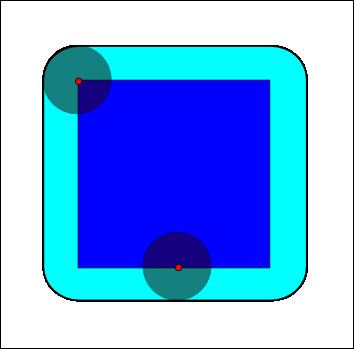 | ||
Dilation (usually represented by ⊕) is one of the basic operations in mathematical morphology. Originally developed for binary images, it has been expanded first to grayscale images, and then to complete lattices. The dilation operation usually uses a structuring element for probing and expanding the shapes contained in the input image.
Contents
Binary dilation
In binary morphology, dilation is a shift-invariant (translation invariant) operator, equivalent to Minkowski addition.
A binary image is viewed in mathematical morphology as a subset of a Euclidean space Rd or the integer grid Zd, for some dimension d. Let E be a Euclidean space or an integer grid, A a binary image in E, and B a structuring element regarded as a subset of Rd.
The dilation of A by B is defined by:
where Ab is the translation of A by b.
Dilation is commutative, also given by:
If B has a center on the origin, then the dilation of A by B can be understood as the locus of the points covered by B when the center of B moves inside A. The dilation of a square of size 10, centered at the origin, by a disk of radius 2, also centered at the origin, is a square of side 14, with rounded corners, centered at the origin. The radius of the rounded corners is 2.
The dilation can also be obtained by:
Example
Suppose A is the following 11 x 11 matrix and B is the following 3 x 3 matrix:
0 0 0 0 0 0 0 0 0 0 0 0 1 1 1 1 0 0 1 1 1 0 0 1 1 1 1 0 0 1 1 1 0 0 1 1 1 1 1 1 1 1 1 0 0 1 1 1 1 1 1 1 1 1 0 1 1 1 0 1 1 0 0 0 1 1 1 1 0 1 1 1 0 1 1 0 0 0 1 1 1 1 0 1 1 1 0 1 1 0 0 0 1 1 1 1 0 0 1 1 1 1 1 1 1 0 0 0 0 1 1 1 1 1 1 1 0 0 0 0 0 0 0 0 0 0 0 0 0 0For each pixel in A, superimpose the center of B.
Each pixel of every superimposed B is included in the dilation of A by B.
The dilation of A by B is given by this 11 x 11 matrix.
1 1 1 1 1 1 1 1 1 1 1 1 1 1 1 1 1 1 1 1 1 1 1 1 1 1 1 1 1 1 1 1 1 1 1 1 1 1 1 1 1 1 1 1 1 1 1 1 1 1 1 1 1 1 1 1 1 1 1 1 1 1 1 1 1 1 1 1 1 1 0 1 1 1 1 1 1 1 1 1 1 1 1 1 1 1 1 1 1 1 1 1 1 1 1 1 1 1 1 1 1 1 1 1 1 1 1 1 0 0 1 1 1 1 1 1 1 1 1 0 0Properties of binary dilation
Here are some properties of the binary dilation operator
Grayscale dilation
In grayscale morphology, images are functions mapping a Euclidean space or grid E into
Grayscale structuring elements are also functions of the same format, called "structuring functions".
Denoting an image by f(x) and the structuring function by b(x), the grayscale dilation of f by b is given by
where "sup" denotes the supremum.
Flat structuring functions
It is common to use flat structuring elements in morphological applications. Flat structuring functions are functions b(x) in the form
where
In this case, the dilation is greatly simplified, and given by
(Suppose x = (px, qx), z = (pz, qz), then x − z = (px − pz, qx − qz).)
In the bounded, discrete case (E is a grid and B is bounded), the supremum operator can be replaced by the maximum. Thus, dilation is a particular case of order statistics filters, returning the maximum value within a moving window (the symmetric of the structuring function support B).
Dilation on complete lattices
Complete lattices are partially ordered sets, where every subset has an infimum and a supremum. In particular, it contains a least element and a greatest element (also denoted "universe").
Let
A dilation is any operator
